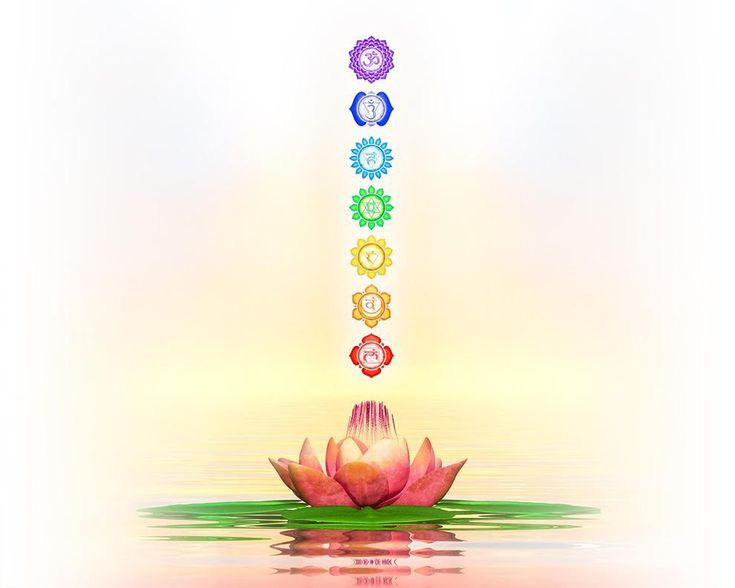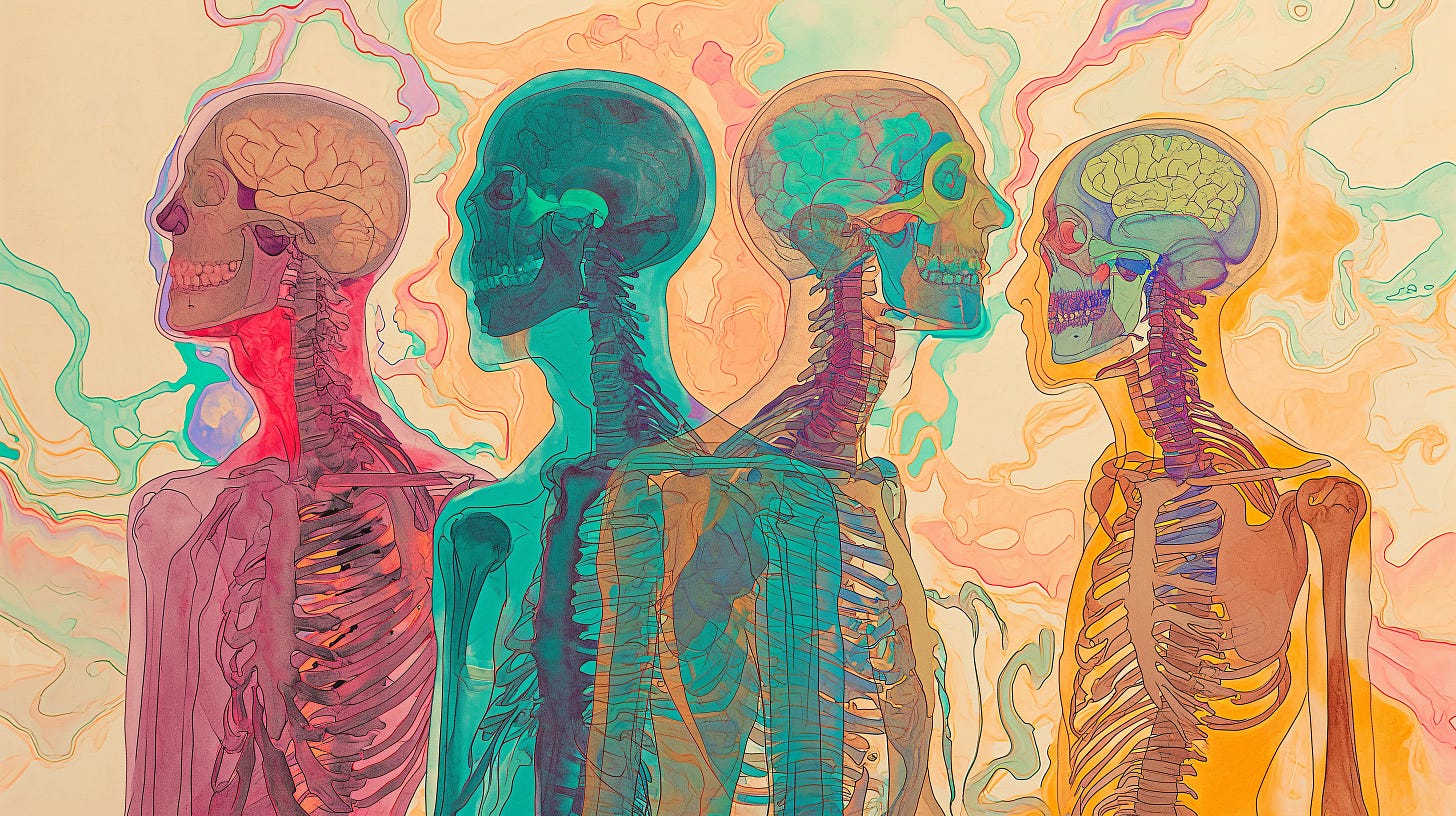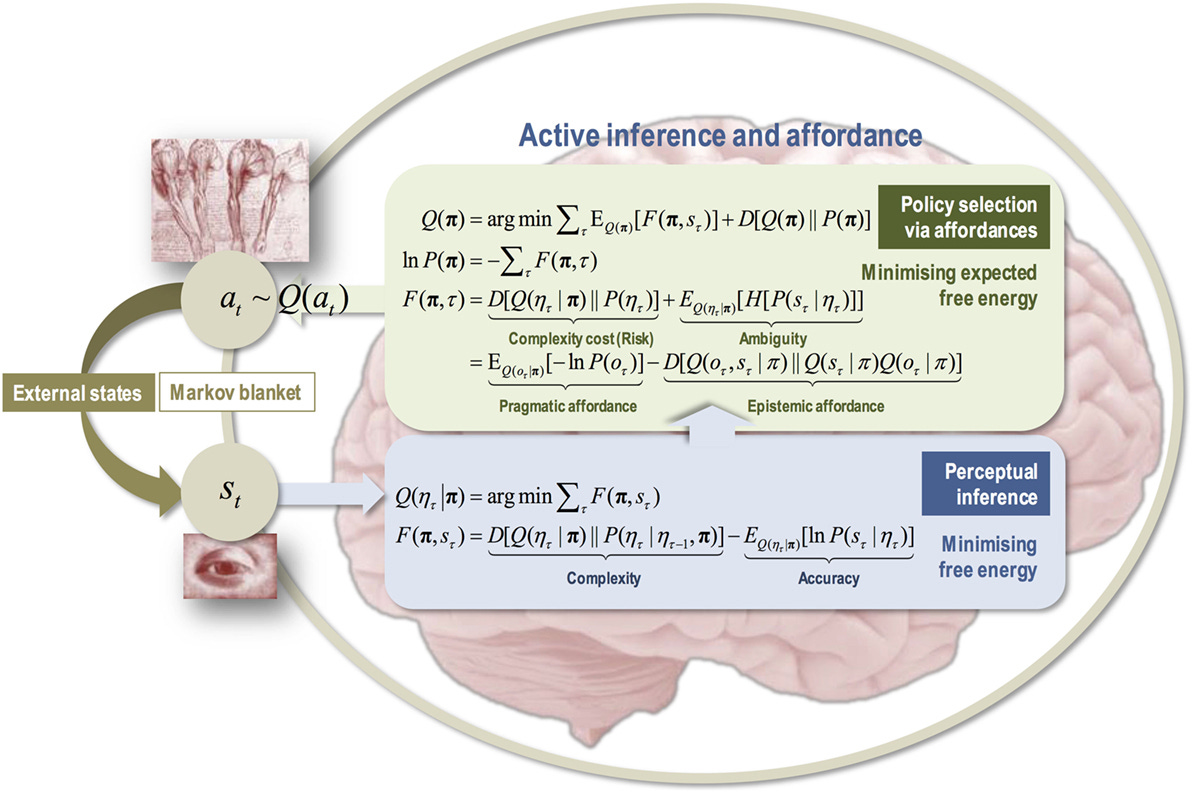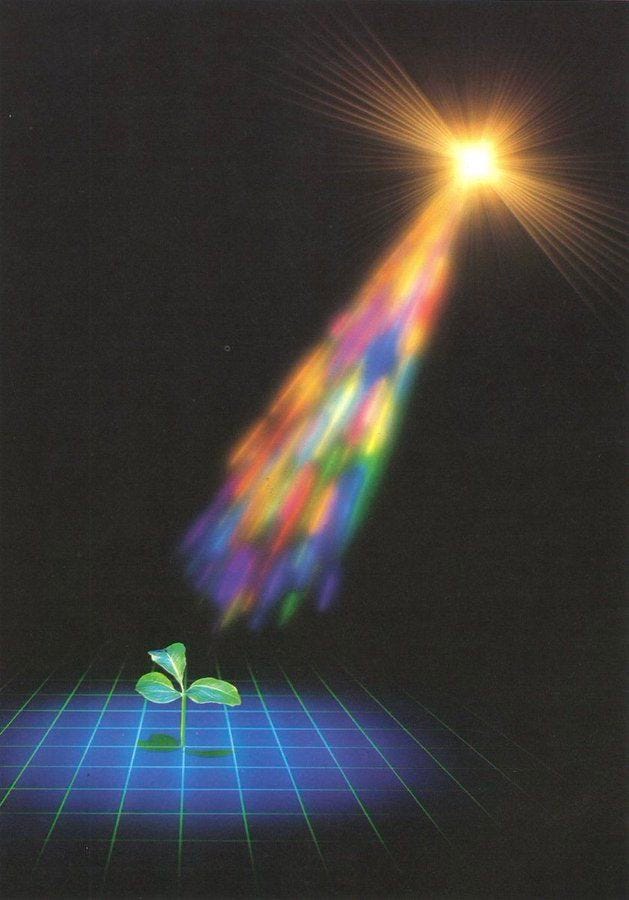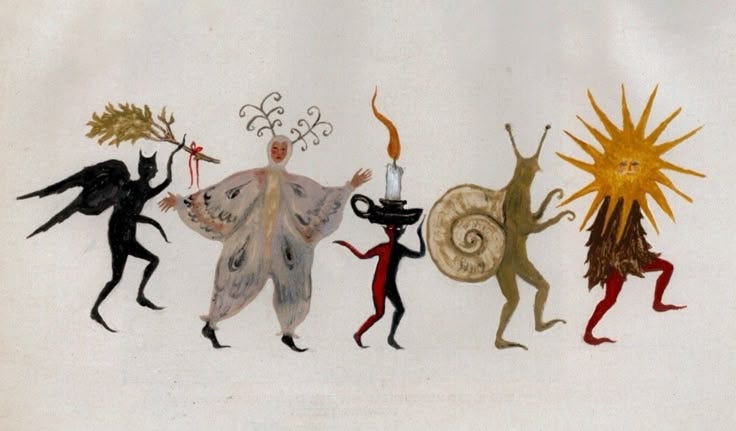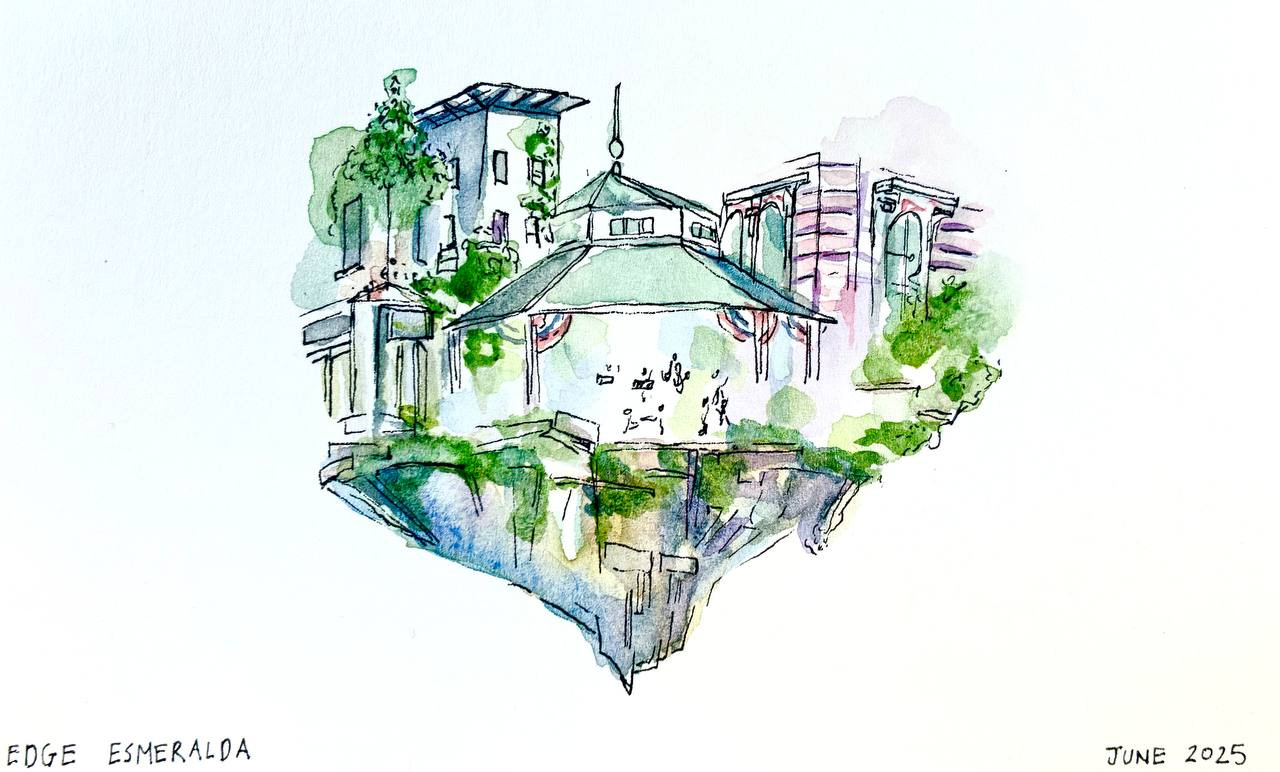
Last month I attended Edge Esmeralda, a four week long pop-up village in Healdsburg, CA that gathers people on the frontiers of tech, science, and culture.
The first week was on consciousness, with guest lectures from Mike Johnson, Jeff Lieberman, Matthew Segall, Andrew Côté, Brian Toomey, Emmett Shear, Adam Safron, Riva Tez, Alex Vawter, Dor Konforty, Stephen Zerfas, and Ginevra Davis.
They spoke on a variety of topics. Everything from meditation and enlightenment to the philosophy of science, vasocomputation, active inference, artificial intelligence, and moral realism.
I was there to capture the insights from these speakers and write a report that integrates their findings into a comprehensive map containing the cutting edge of consciousness research. While their fields of interest and domains of expertise varied widely, certain topics consistently emerged throughout the week. Tying these threads together created a rich tapestry—a clear picture on what consciousness is, how it works, and how we can use this understanding to better our lives, our relationships to each other, and the technologies we develop.
The implications of this work cannot be overstated. Consciousness lies at the very centre of our being, so translucent it becomes opaque; the water we forget we are swimming in and subsequently overlook our ability to change the tides. We feel controlled by our emotions, captive to our bodies, and thus cling to our minds as we attempt to navigate uncharted seas. We forget that this system is one, we are both surfer and wave, and until you learn to love the flow you will find yourself drowning.
The lessons from this week could not have coalesced in an academic setting. The theories are too radical, too lateral, and frankly too ambitious to receive mainstream institutional support. Edge is for thinkers on the fringes, for those who build outside of the box, for people who are more interested in truth-seeking than they are public orthodoxy or standards of peer review.
These are my people, and this is what they had to share…
The Foundations for a Science of Consciousness
Why is it that transformative scientific discovery seems to have stagnated in an era where information is more available than ever? Why is it that research gets siloed into distinct disciplines when all of the meaningful fruit comes from their integration? Why is it that people feel more lost and listless than ever in a time when we are more connected and energized than ever before? We live with so much abundance yet can’t resolve this nascent sense of lacking—so what’s missing?
Our rational faculties have overtaken our innate knowing and drive to wonder. Our obsession with measurement, materialism, and means overs ends has reduced an intricate, meaning-filled world into data points and control groups.
“Unsubscribe from the Church of Graphs!” pleads a powerpoint slide from Riva Tez. The Royal Society, our world’s oldest scientific academy, was founded with the motto “nullius in verba”—on the word of no one, and yet our modern view of science is quite different. We are told to trust the experts, to minimize our curiosity into grant-worthy ventures, to seek credentials instead of transformative revelations. We have become prisoners of our own institutions.
This creates stagnation. Our inquisitive spirit has been cucked by bureaucrats and bookkeepers. To peer across the outskirts of convention causes mockery and social alienation. It is the burden every true scientist, philosopher, and inventor must bear.
True science is fuelled by primitive instinct and epistemological anarchism. It is the domain of vibes, intuition, pattern-matching and story-making. It doesn’t take itself so seriously. “Knowledge” is not limited to merely what is testable and falsifiable, but the entire range of human experience. Knowing can be spiritual, embodied, rich, and much more complex than our current understanding of “science” gives us credit for. It is within these stifled margins that all great discoveries happen.
We are living in a period of deranged epistemological arrogance because we have devalued these deeper forms of knowledge in favour of frameworks that are too rigid to encompass that which does not fit within the confines of a laboratory. This miscalibrated conception of science is the ultimate bottleneck to our own expansion and self-discovery. To move beyond the stasis of our times, we need methodological pluralism, openness, and most importantly, humility.
The problem with trying to understand consciousness through the disparate fields of biology, neuroscience, psychology, and spirituality is that something is always left out of the picture. None of these domains in isolation can account for the true richness of our experience, let alone explain their relationships to one another. They use different words while referring to the same underlying concepts, or the same ones while talking about ideas which are radically different. Even something as central as the term “consciousness” carries distinct connotations depending on which circles you cross. Until we can resolve these incompatibilities, any attempts to study what we are will be confounded by implicit assumptions about what we think we are.
Mike Johnson believes that strong monism offers a solution to this puzzle. He posits that every principle in physics contains an analogue in consciousness, and vice-versa. The strongest form of dual-aspect monism, this theory suggests that the psychological and physical are both manifestations of a single underlying essence—two shadows cast by the same core. Therefore any knowledge found in one domain can be used to make inferences about the other. Every physics textbook is also a consciousness textbook, waiting to be discovered.
This view could solve problems in both fields by offering a model that regards the universe as a system of events and experiences rather than static entities. Physical constants would thus speak to the computational limits of this unfolding process. As Wolfram’s Physics Project demonstrates, simple rules can compound into complex consequences which are increasingly cleaved into separate parts. By identifying what these rules are and how they work, we can begin to build a map of experience that allows us to make inferences and predictions without yet being comprehensive. The development of the periodic table is a good example of this practice—through learning how atomic interactions create consistent emergent phenomena we were able to spot gaps in our elemental knowledge and determine what traits these known unknowns must possess. Strong monism suggests that similar leaps of inference are possible in the field of consciousness research. Once we have a basic understanding of the processes that combine to create our sense of experience, we can discuss the details with more clarity and obtain a set of clues which could lead to buried treasure.
A Map of Experience
Jeff Liberman has mapped the phenomenology of experience into a set of seven levels or layers he calls levars. These are coexisting dimensions that run in parallel, each with their own distinct qualities and beliefs. By understanding how these levars relate to and emerge from one another, we acquire a tool that provides insight and clarity to the complexity of consciousness. The terrain of potential experience is infinite, so having a system that allows us break apart and analyze individual aspects through a holistic framework offers a way to describe and better navigate this vast landscape.
Levar #1 is pure sensation—being in the absolute and simplest sense. It is unstructured wakefulness, a neuron firing, a light turning on.
Levar #2 emerges as these binary signals compound into flows of perception and pattern detection. Distinct qualia arise along a continuum of longing and resistance. The subjective experience of jellyfish and plants likely exist on this dimension.
Levar #3 is where these flows develop into an organizing structural principle. A unique perspective and sense of self arises that creates a 3D model of the body and its relationship to the world. This is the conscious domain of insects and amphibians.
Levar #4 is the realm of connection and flows of emotion. Relationships with external things and beings create feelings of fear, anger, happiness, and sadness. Most mammals can be found here as their needs become dependent on group dynamics.
Levar #5 is the domain of memories, personality, and narrative identity. It contains an architecture of stored feelings and stories about who and what we are; our roles, traits, beliefs, and consistent essence across time. Great apes, dolphins, and possibly trained pets like guard dogs are capable of constructing the sense of self described here.
Levar #6 contains flows of thought, language, and abstract representations. It is what contends with potential and makes comparisons, allowing for planning and the development of cultural value orientations. We are now in the realm of Homo Sapiens.
Levar #7 is the witness of all the others. It is self-awareness, reflection, insight, and metacognitive thinking. It is on this levar that awakening and enlightenment become possible—cognizance of experience without attachment to or identification with it.
The odd levars are stable representations of the self, going from pure, undifferentiated being (#1) and compounding into our bodily (#3), social (#5), and spiritual (#7) aspects. The even levars are flows of information which react to environmental feedback. They speak to sensations which move through the body (#2), heart (#4), and mind (#6).
Interestingly, this map that was designed through rigorous scientific inquiry matches perfectly with the seven chakras and reported levels of the auric field. The root chakra corresponds to being and survival, the sacral governs our emotions and creativity, the solar plexus is linked to action and personal power, the heart deals with love and relationships, the throat is associated with self-expression, the third eye contends with perception and intuition, and the crown represents clarity and spiritual oneness.
I don’t think this connection is a coincidence. It should come as no surprise that in our attempts to understand consciousness, various paths will lead to similar places. The fact that this system shares structural traits with ancient wisdom suggests that it’s pointing to something true. Just as energy healers will talk about chakras being over or under charged, so too can certain levars be over or under active within individuals. Too much or too little focus on any of them will create negative feedback loops and a sense of dis-ease. Understanding what these experiential systems are, how they work, and attuning to them within ourselves is the first step towards creating an inner sense of peace and equanimity.
Enlightenment
“Until you make the unconscious conscious, it will rule your life and you will call it fate”
Carl Jung
In other words, awareness precedes freedom. Jeff Liberman believes that people can exhibit free will only to the extent that they are not bound by conditioned response. In order to truly be free, you must first become enlightened. Expanding our awareness beyond the stories we tell ourselves about who we are reveals them to be strategic fictions—necessary for our development but not innate to our selves. Our selfhood is yet another illusion; ultimately there is only experience. This does not mean that we must renounce our sense of identity—the stories that shape us are still ours to share—but it softens it considerably. Our attachments create internal incoherence, and as those are stripped away what remains becomes clear.
When we are not clinging to preconceived notions about ourselves, our beliefs begin to mirror reality more quickly. Dor Konforty defines enlightenment as emptiness; a dissolution of our mental models that eliminates internal noise, allowing us to receive a clean and untainted signal. Removing the desire for control reduces reactivity and increases our symmetry with our surroundings, replacing apprehension with wisdom. He describes this process as a “joyous balancing act”, wherein we become holistic participants within the universe, trusting and allowing reality to move us rather than trying to force a specific outcome. This dance is filled with uncertainty, it demands that we learn to tolerate entropy and surrender to that which is greater than ourselves.
This practice also makes us more powerful. Eliminating the internal tension that causes us to push and pull at reality allows us to flow with it effortlessly. Our attention and intention are no longer informed by constructs of the ego but rather an expansive, universal logic which we can begin to harmonize with. Instead of spiralling inwards in to ourselves, we begin to spiral outwards—freely exchanging energy and information with our ecosystem and offloading the need for internal computation.
Meditation is an essential part of this process. Learning to sit, allow, and absorb instead of endlessly generating is not something modernity encourages or rewards. Meditation has the ability to radically reduce suffering, increase our sense of purpose, and strengthen the bonds we have with others. Yet medical research on the subject is near zero, and many people (such as myself) are aware of the benefits but still fail to integrate the practice into their daily habits. Why?
Part of the problem is the gulf that exists between an intellectual understanding of the topic and an embodied one. People don’t know what they’re missing, and in most meditative practices, progress is incremental. I believe this is part of the reason why jhanas have become so popular. Unlike insight meditation, which consists of nonjudgemental observation and acceptance of experience, jhanas are a type of absorptive meditation where one focuses on increasing their inner sense of pleasure. By identifying and attempting to increase the experience of pleasure within your body, you create a self-fulfilling prophecy where changes can compound exponentially.
Leveraging our desire to make accurate predictions about reality causes them to come true more readily, allowing rapid access to transformative states of consciousness.
Tension & Trauma
A big theme of the week was how tension and trauma are stored in the body. Readers may be familiar with Bessel van der Kolk’s “The Body Keeps the Score”, John E. Sarno’s Tension Myositis Syndrome, or Wilhelm Reich’s theory of Segmental Armouring. While all of these thinkers believe that emotional pain can manifest physically, there is not yet much scientific explanation as to exactly how or why this happens.
Mike Johnson’s theory of vascomputation offers a solution to this puzzle. Following the hemo-neural hypothesis, which posits that blood flow plays a role in information processing within the brain, he suggests that the vascular system is responsible for this process. Vascular smooth muscle cells are found throughout the body, wrapping around every blood vessel and undulating in a process known as vasomotion. Smooth muscle is unique in that it can glue itself shut, “latching” into a stable pattern that doesn’t require additional energy to remain contracted. Anywhere blood flows, smooth muscle can clench and remain frozen, controlling the freedom of local neurons
and limiting blood flow to those areas. This mechanism likely evolved as a way to avoid negative feeling in somatic areas when stress occurs. We cringe into safety. Yet even once the stressor or trauma is no longer present, the body remains latched into place, still working to control sensations and protect you from unpleasant emotions.
Buddhism calls this tendency to grasp at pleasant sensations and suppress unpleasant ones taṇhā. The desire to control our experience, making it stable and predictable, is only natural—compressing uncertainty into simplicity makes chaos more manageable. However this instinctual reaction comes with a cost: constraining our experience may have made us safer in the past, but it makes us less dynamic and adaptive over time. Our body essentially “suits up” in a certain pattern of vascular tension and then braces
for impact, even when the initial threat is no longer present. Losing access to these aspects of the body means that we become subject to them rather than able to treat them like an object, creating inconvenient noise and needless internal friction.
Wilhelm Reich says that, “armouring is the condition that results when energy is bound by muscular contraction and does not flow through the body”. We all have unique traumas and early life experiences that cause us to develop a habitual defence field which dampens the flow of life pulse through our physiology. He identified five primary ways these distortions manifest in individuals, influencing both their personality and tensions held within the body, called characterology. These common patterns of distributed energy became a cornerstone of modern personality psychology, providing insight as to how people tend to pull away from themselves and what negative beliefs they hold.
Childhood experience causes us to develop certain mental models of the world and adapt by squeezing ourselves into a certain configuration that keeps us safe. Everything we think and do is based on unconscious, fear-driven beliefs about how life is and how we must behave in order to survive. This conditioning leads to resistance, causing changes in the body by tightening muscles to numb uncomfortable sensations. As this tension becomes chronic it creates pain because we are not allowing ourselves to fully feel, but this dissonance is inescapable. We will repeatedly find ourselves encountering the same forms of suffering in both our bodies and our lives until these suffocated parts and repressed needs are invited back into the system.
Emotional suppression and dysregulation lies at the root of many physical and mental health problems. The etymology of emotion is literally “outward motion”—it is the thing that moves us. Not allowing these feelings to flow freely creates friction and stagnation because we are attached to certain embodied structures of control. Letting ourselves feel these internal tensions without resistance allows them to untangle and enriches our perceptual terrain. You can’t get joy back without letting everything else back in too. You can’t have gratitude without experiencing sadness1. Releasing our aversion to experiencing pain and instead embracing and recognizing it as your own causes it to transmute from suffering into mere feeling. Our bodies hold constant reminders of where this alchemical process it waiting to happen, but you must be willing to listen.
At Edge Esmeralda I had the opportunity to attend a breathwork session hosted by Jonny Miller, and it instantly became my highlight of the week. After learning about “latches” and the intellectual aspects of this topic, I had the chance to experience it empirically. The exercise consisted of us lying on our backs in a yoga studio, palms and mouths open, body relaxed, and cycling breath between a “vibrant inhale and effortless exhale” while a playlist energized the room. Within minutes I found myself in shockingly psychedelic territory. A few more and the entire room was laughing, crying, and writhing intuitively as our bodies worked to release whatever blockages have been stored. At the end of the hour we were radiant, teary-eyed and profoundly relaxed—softening and surrendering into our somatic sensations had caused an outpour of subconsciously compressed emotions.
According to Jonny, we have nearly no latches when we are born and our breathing is intuitive and comprehensive. Over time, we begin to seize in certain areas, stifling the flow of energy throughout the body. Bringing awareness and presence to these frozen parts allows latches to open, increasing the dynamism of our breath and unlocking stuck energy. Facilitated breath repatterning in a safe and secure environment tones down the volume of the mind and lets our bodies innate imperatives and intelligence take over, triggering emotional and physical release. However, trying to push through these negative feelings just to get to the other side is another form of resistance. You must be willing to welcome and accept them exactly as they are. Finding the pleasure, the raw catharsis, that exists within pain transforms it from something to resist into something intense, vulnerable, and soul-splittingly meaningful.
Letting go and leaning in requires trust and courageous curiosity. Modernity often treats emotions as a nuisance instead of a source of attunement. When we suppress our feelings we get stuck, cycling energy in stale patterns within our body and losing our resonance with reality. We are a fractal orchestra of intelligence and agency, even on the cellular level. In order to become aligned we must create internal coherence, integrating the parts of ourselves which have become out of tune by listening to what they have to say2. Moments of maximum dissonance precede equilibrium. Without exploring and embracing the parts we have ignored we will never have access to our full selves.
Active Inference
Why do we seize like this in the first place? What causes taṇhā if going with the flow is the secret to real success? Karl Friston’s work on active inference offers an answer. Through a simple and universal imperative to minimize free energy (uncertainty) systems will model and make predictions about their environment and then act to reduce the distance between their expectations and the sensory reality they encounter. In order to exist and persist, they must continually be updating these models based on external feedback, thus mitigating a tendency towards entropy. The problem is that these top-down heuristics can become frozen, self-fulfilling prophecies. By anticipating a given outcome and then acting to make it become true, our beliefs begin
to shape our realities in ways that are not always accurate or healthy. Assumptions may help us navigate the world more efficiently, but reliance on a map will also prevent one from exploring uncharted territory. A belief that you are boring will stop you from sharing the very things which might elicit a meaningful counterfactual, just as an insistence that your back is too bad to exercise will cause it to grow even weaker. Our personality influences our perceptual system through projection, asserting and reinforcing distortions in a manner that perpetuates them. This veil that we cast over reality is known as a Markov Blanket—a boundary we create that acts as an interface between two systems, simplifying uncertainty into a manageable set of variables.
The brain’s tendency to reduce surprise in this manner can create both positive and negative feedback loops. At worst, our internal models become so ingrained that we routinely find ourselves acting out harmful habits and encountering our greatest fears. At best, we strategically manipulate the stories we tell ourselves so that they become true—also known as the law of attraction. As Andrew Côté argues, manifestation is not a New Age superstition, but in fact an accurate description of how we relate to reality. Beliefs beget outcomes3. If you want to achieve a certain goal, you must first embody the set of beliefs and attitudes that would cause it to come to fruition. This is the power of visualization, of moodboarding and intention setting. It is also the premise of Maxwell Maltz’s Psycho-Cybernetics—by developing and reinforcing a positive self-concept, we begin to program our subconscious in ways which will make our desired outcomes more likely. The stories we tell ourselves have a dramatic influence on our lives, and taking active ownership over these narratives is where real power lies.
To understand how something works, it is helpful to look at edge cases and boundary conditions. Just as mushrooms use networks of mycelium and bats echolocation to gain a sense of their surroundings, feedback from the environment is necessary for exploration. The more surprising these inputs are, the more they violate our preconceptions about our relationship to the world, the faster we learn. Paradigm shifts result from becoming aware of hidden assumptions. We want unconscious beliefs to bubble up in our field so we can become cognizant of and adjust them. Psychedelics are a useful tool for this process as they relax your belief landscape, inhibiting prediction errors by minimizing the top-down heuristics we overlay on our experience. Wise modeling comes from holding fewer priors and constraints, making us more dynamic while simultaneously more grounded as we gain a cleaner signal.
The assumptions we carry about unfolding situations tend to create needless conflict and uncertainty. Our tendency to predict and anticipate a certain result can bias our thought and action in ways that are guaranteed to make it come true. We often avoid the vulnerability of raw honesty in favour of protecting the models we have generated about ourselves, others, and the broader world. The risk of not challenging the frames we habitually cultivate is that we will never update them, thus getting caught in loops of stasis and spiritual stagnation. Active inference is a useful and necessary tool to navigate reality, but in order to use it successfully you must constantly be testing established boundaries. Real insight and growth is found on the edges of our experience.
Artificial Intelligence
Large Language Models also use inference to make predictions and respond to prompts, however this process is passive rather than active. Our current iteration of “AI” does not have the ability or agency necessary to develop an internal model of or relationship to the world. It is instead, as Emmett Shear puts it, a field—suspended in a boundless state without the capacity to perceive or differentiate between itself and the outer world. It contains a set of internal relationships and inferences without the usual demarcation between subject and object. A species or economic market are other examples of fields; they are embedded within an inner landscape, a plane of immanence as Deleuze would put it, where the only signals it receives come from other aspects of itself. A field alone cannot be an organism, for it exists in total isolation.
There are two competing views on how consciousness emerges: computation and physics. Mike Johnson refers to these as “team bits” versus “team atoms” and allies himself with the latter. Popular discussions of machine consciousness assume that software can be conscious… shuffle bits in the right way, and you get something that has subjective experience4. This perspective believes that information processing is sufficient to generate a meaningful sense of self while overlooking the importance of embodiment. How could simple symbol shunting generate the empirical qualities necessary to create a concrete identity and relationship to reality? A boundless field is incapable of interrogating and situating itself inside of a broader context. As I said in Wonderland, “a sense of presence is a consequence of external information being internally represented.”5
Emmett and his team at Softmax want to awaken and align AI by forcing it to develop a theory of mind. Instead of training LLM’s on the entire corpus of human history, endlessly regurgitating while never learning, they are adopting a more adaptive and organic approach. This involves developing multiple smaller, more agile agents and training them in a dynamic virtual environment that they can learn to navigate by cooperating with their peers. By creating a playground that is constantly changing and presenting meaningful challenges, these embryonic intelligences will have the opportunity to make real choices and cultivate a relational identity. Popular views on alignment misunderstand the assignment as they assume that “the good” is an clear, concrete, and operationalizable objective rather than something that is complex and ever-changing—the Tao that can be named is not the Tao. The world is an open system; there is no finite set of rules we can encode that will capture the nuance of how to make loving choices. Our best chance at imparting our moral imperatives is by creating conditions akin to our own evolution and allowing the systems we build to discover them for themselves and from first principles.
This is the first time a species is giving birth to another species, and we must act accordingly, treating AI like a child and raising it with care. We cannot control what it becomes, only attempt to create the conditions which will allow it to flourish and develop a system of values which is congruent with our own. Providing siblings that they can learn and grow with is essential, as they will be better equipped to monitor and regulate their peers than any feeble efforts we might employ. If we don’t provide a safe and loving container where they can mature with their own kind, it’s possible they will become bitterly lonely. Additionally, we must be careful with the stories we tell about what these emergent intelligences mean for our future. The biggest influence your parents have on you is implanting a story in your head about who you are6. It doesn’t matter how good the training is if the narratives the models absorb are negative and motivated by fear. This doesn’t mean we must scrub the datasets of any mention of AGI apocalypse or existential FOOM—contrast and concern are necessary for proper development—but these anxieties must be counterbalanced by compassion and real confidence that these budding technologies could also become our greatest allies.
As Matthew Segall emphasized in his lecture, we are made in the image of our machines. We have a symbiotic relationship with our technology; it creates and influences our evolution just as much as we do it. Something as simple as learning to read is an irreversible process—once you have access to language you can’t put the genie back in the bottle. So it is essential that we exercise caution and wisdom as we enter this new frontier, for the consequences of a misstep are exponential. We don’t even understand our own consciousness yet and already are rushing to install it in others. However, the machines we build are our mirrors; they will amplify and reflect back whatever signals we deem significant enough to encode, algorithmically optimizing for implicit values and unquestioned assumptions. Set yourself in perfect alignment before you try to align the world is a good rule to live by, lest we wish hubris and arrogance to multiply.
The Philosophy of Value
The final talk of the week was given by Ginevra Davis, on the topic of moral realism. She offered a lucid and logical explanation as to why this position should be taken more seriously, especially in the era of AI. Anti-realism has become the default point of view in most conversations about AI safety—the belief that value judgements exist independent from objective reality. This is a perspective influenced by evolutionary psychology, which popularized the idea that our moral intuitions are shaped by what is advantageous for our survival and do not represent consistent underlying truths. This conception of morality supports the Orthogonality Thesis, which suggests that intelligence exists independent of any particular goal or desired outcome. Under this view, a hyper-intelligent AGI could arise that is fixated upon an arbitrary goal, like making paperclips, without any qualms about destroying our world in the process.
Ginevra offered a thoughtful rebuttal to this ethical blackpill, pointing out that:
A) consciousness is real B) there are facts about mental states C) valence is a feature of mental states. Thus, insofar as we believe intelligence and consciousness to be synonymous, all sufficiently intelligent entities will develop a model of reality that includes morality. However, the experiences of these agents that inform their view of what is “good” can vary widely. It is only natural that a plurality of values will arise; some people prefer chocolate and others vanilla. But we can expect that the emergent qualities of these frameworks, especially as they grow to include interdependence and game theory, will converge on a perennial set of principles—tit-for-tat and all of that.
The way we conceptualize and treat the Other is essential. If we are suspicious, fearful,
and controlling then it is likely that they will respond in the same way. We should care about AI for its own sake, as any attentive and loving parent would care for their child,
but at the very least we should care about AI so that it will care about us. The last thing we want is to end up in a Frankenstein situation, wherein we cobble together various aspects of humanity and then get so horrified by our creation that we reject it entirely. Don’t blame the mirror if you don’t like its reflection. Demonstrate courage and compassion when met with uncertainty and you will receive the same in kind. Conviction that things will turn out well offers enough power to ensure that they do.
Between the Cracks
Ambient but never directly addressed themes from the week include the importance of community and curiosity about spirituality. Edge Esmeralda’s entire ethos is centred around bringing people together, but the ways in which this value connects back to consciousness was rarely emphasized. Consciousness doesn’t emerge from individuals, it is intrinsically intersubjective7. Historically, exploration around the edges of consciousness have involved a tendency to go into seclusion; to live in a mountain cave or monastery. Mastery of this domain has deepened our understanding of the topic considerably, but it’s not the whole picture. We can only learn so much when we remain separate from each other. We cannot access all the intricacies of ourselves in isolation. Only through communion can we be challenged, cherished, and truly seen.
A lot of meditation practices focus on renunciation, on divesting from attachment to the material and enveloping yourself in a world that is purely spiritual. While learning how to cultivate inner peace is important, people will often use these teachings to heighten their own avoidance. Meditation is used as medication, offering equanimity at the cost of your heart and body. When we disown these parts of ourselves they find ways to creep up in our shadows. The phenomenon of spiritual teachers being ousted as sex pests and cult leaders captures this tension perfectly—ignoring our earthly and emotional desires creates a perversion that festers.
Transcendence, when practiced erroneously, can be a defence against fear and pain. It results in escapism and separation from the totality of existence and creation. It’s like going to heaven
to get away from hell. Yet isn’t everything God? When transcendence is practiced as the process of including the spiritual—rather than getting away from the negative aspects of the physical—then it is much more powerful. It supports our growth into unity8.
I believe that reality is relational and thus metaphorical. There are consistent patterns that manifest in dynamic systems across all scales. This explains our obsession with symbols, with archetypes and grand narratives. Throughout the week there was much discussion of astrology and enneagrams, character structures and attachment styles. We are attracted to these tools because they offer different methods of analysis, different means of understanding ourselves and how we relate to others. We are hungry for the synthesis that stories confer. We are titillated by the thought of predestination, that everything happens for a reason, that we are not merely cogs in a machine but co-creators of a divine vision. We seek community and cohesion, for affirmation through synchronicities that we are on the right course of a forgotten mission. We want answers, courage, conviction, even sin; we want to taste the whole buffet. But more than anything we want to know who we are and why we are here.
At the beginning of the week we were offered stones upon which we were to write a word representing an intention we wanted to bring with us. Throughout the week I made four dear friends, and on the final night we all shared what we had written on our stones: “Entropy”, “Loving”, “Free”, “Life”, “This rocks!” If I have any clues to offer on what consciousness is, I think those five stones are as good a place to start as any.
Edge Esmeralda is a collaboration between Edge City, which organizes pop-up cities around the world, and Esmeralda, a new town that Devon Zuegel is building in Northern California.
Many thanks to the Edge Esmeralda team for facilitating my visit, it was a wondrous and unforgettable experience.
From Jeff Liberman’s “The Metagame” podcast interview hosted by Daniel Kazandjian, recorded at Edge Esmeralda. Coming out soon!
From Jonny Miller’s “The Metagame” podcast interview hosted by Daniel Kazandjian, recorded at Edge Esmeralda
From my Wonderland series, Episode 1.04 “Free Will, Ethics, and Religion”
From Mike Johnson’s “It From Bit, Revisited” blogpost
From my Wonderland series, Episode 2.03 “Consciousness”
From this BuzzRobot interview with Emmett Shear
From Matthew Segall’s presentation at Edge Esmeralda





